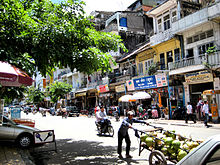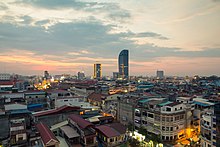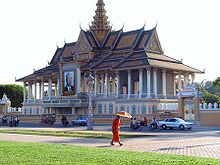Phnom Penh
| ភ្នំពេញ Phnom Penh |
||
|---|---|---|
|
|
||
| Coordinates | 11 ° 33 ' N , 104 ° 55' E | |
| Basic data | ||
| Country | Cambodia | |
| Phnom Penh | ||
| ISO 3166-2 | KH-12 | |
| surface | 376 km² | |
| Residents | 1,501,725 (2012) | |
| density | 3,993.9 Ew. / km² | |
| Post Code | 12101-12415 | |
| Website | www.phnompenh.gov.kh | |
| politics | ||
| mayor | Kep Chuk Tema | |
|
National Assembly of Cambodia
|
||
Phnom Penh ( Khmer ភ្នំពេញ , transcription: Phnum Pénh , IPA : [ pʰnum peːɲ ], German 'Hill Penh') is the capital of Cambodia .
Phnom Penh has 1.5 million inhabitants (as of 2012) and is located in the south of the country on the Tonle Sap , a tributary of the Mekong . The city is home to the Royal University of Phnom Penh and a technical college. There is an international airport . The city can also be reached by smaller seagoing vessels via the Mekong. Phnom Penh is by far the most important economic center in the country.
history
The city takes its name from Wat Phnom Daun Penh (Hill Temple of the Old Woman Penh), which was built in 1372 on an artificial hill 27 meters high to house five statues of the Buddha .
In 1434 the last ruler of Angkor moved his residence to the greater area of today's Phnom Penh, to Lovek , after Angkor was conquered by Ayutthaya , the kingdom of the Thai , and its vital irrigation system was destroyed in 1431 . In the 16th century Lovek was abandoned. It was not until 1866 that King Norodom I moved his seat of government from Udon to Phnom Penh under pressure from the French. In 1867 the city also became the seat of the French colonial administration . The French planned and rebuilt the city. In order to be able to drain the marshland in today's urban area, a canal system was created. Since 1969 a railway line has connected Phnom Penh with the port city of Kompong Som, today's Sihanoukville .
Before Cambodia gained political independence in 1953, the urban population of Phnom Penh consisted of one third each of Vietnamese, Chinese and Khmer. It was not until the second half of the 1950s that the demographic ratio began to shift significantly in favor of the Khmer. Today the Vietnamese and Chinese make up a numerically small but economically more influential minority of the city's population.
Indochina War

During the Second Indochina War , Phnom Penh was attacked several times by Viet Cong units. Against the background of the heavy bombing of Cambodia by the US Air Force (1969–1972) and the military clashes between the government troops of General Lon Nol and the Khmer Rouge , tens of thousands of peasant families fled to the city, which had grown to around two million inhabitants in early 1975 .
Rule of the Khmer Rouge: 1975–1978
On April 17, 1975, Phnom Penh was conquered by the Khmer Rouge. They immediately deported almost the entire urban population to the countryside; shortly after the seizure of power, around 20,000 people lived in the city, mainly party officials and other elites. From February to May 1976 the Pol Pot regime significantly strengthened the military security of the capital with a garrison of almost 20,000 soldiers. There were several reasons for the deportation of the urban population in April 1975: On the one hand, there was the logistical problem of being able to supply the population with sufficient food; because in the last months before the seizure of power Phnom Penh had been supplied with food, medicine and fuel by an American airlift. On the other hand, the Khmer Rouge had set a policy goal, building on the kingdom of Angkor an ideologically ajar on Maoism self-sufficient peasant state to create Cities were in the ideological system of the Khmer Rouge as a capitalist and counterrevolutionary. Their population was disenfranchised and declared new people or people of April 17th . A large number of them perished during the Cambodian genocide while working (often forced labor) in agriculture and in prisons as a result of hunger, exhaustion, disease ( malaria ) and executions.
Urban development since 1979
Since the expulsion of the Khmer Rouge by Vietnamese troops in January 1979, the city has slowly started to recover from the Khmer Rouge dictatorship of Pol Pot , and people from the surrounding area have returned to the city, which was almost deserted at the time of the invasion of the Vietnamese army. For years in the 1980s, homeless Cambodians lived in the urban area, keeping cows, pigs and chickens in the streets. From 1992 to 1993 Cambodia was placed under the supervision of the UN , with the result that the foreign soldiers brought large amounts of foreign currency into the city's economy, which triggered a huge boom.
Today Phnom Penh presents itself as a modern city by Cambodian standards with approx. 2 million inhabitants. The city has developed into the most important tourist destination in Cambodia after Angkor in recent years , the reason being the many sights, a now quite pronounced nightlife and restaurants that offer high quality food for little money. There are also various markets with an unmanageable variety of goods and a few shopping centers, which in their modern furnishings, which can also be described as luxurious by Western standards, contrast with the sometimes widespread poverty in the city and throughout the country.
In contrast to the vibrant metropolises of its neighboring countries ( Bangkok , Hồ-Chí-Minh-City ), Phnom Penh still has many tree-lined ( frangipani ) avenues and quiet side streets. Nevertheless, traffic and environmental problems have increased, there are an estimated 500,000 mopeds in the city that blow their exhaust gases into the air and provide all kinds of services with their owners, from taxi rides to truck transport.
Population development of the agglomeration according to the UN
| year | population |
|---|---|
| 1950 | 364,000 |
| 1960 | 389,000 |
| 1970 | 900,000 |
| 1980 | 238,000 |
| 1990 | 615,000 |
| 2000 | 1,149,000 |
| 2010 | 1,523,000 |
| 2017 | 1,893,000 |
climate
Phnom Penh has a tropical climate. It's hot and humid all year round. The rainy season lasts from May to October.
|
Monthly average temperatures and rainfall for Phnom Penh
|
|||||||||||||||||||||||||||||||||||||||||||||||||||||||||||||||||||||||||||||||||||||||||||||||||||||||||||||||||||||||||||||||||||||||||||||||||||||||||||||||||||||
Attractions
Phnom Penh offers a wide variety of architectural attractions. The spectrum ranges from Wat Phnom to the royal palace from the 19th century, in addition to French colonial villas in the city there is the central market Phsar Thmei in the Art Deco style of the 1930s.
After Cambodia gained independence from the French, the city experienced an unprecedented building boom under the patronage of King Norodom Sihanouk . This golden era of modern architecture is also called the New Khmer Architecture . Vann Molyvann , who was appointed national architect by the king and who studied in Paris under Le Corbusier , should be mentioned above all . He and other architects developed a style that can be described as a mixture of Bauhaus , modernity and Angkor tradition . Unique structures such as the National Theater, the House of Ministers, the Institute of Foreign Languages, the National Sports Center, the buildings of the Royal University and villas for the emerging new middle and upper classes were built between 1950 and 1970.
Although these buildings survived the terror of the Khmer Rouge and the turmoil of the civil war that followed, they are now at great risk of demolition. The National Theater was demolished in 2008 and several villas from the 1950s have already been demolished to make way for new buildings. A movement against the destruction of this phase of Phnom Penh's history is slowly emerging , for example mansions have been converted into boutique hotels such as Knai Bang Chatt and Frangipani .
Traditional structures
- Wat Botum - one of five original wats, founded by King Ponhea in 1422
- Wat Langka - also dates from 1422
- Wat Ounalom - housed the Buddhist Institute until 1999
- Wat Phnom - the spiritual center of Phnom Penh on an artificial hill about 27 meters high
- Wat Kampong Tralach Loeu , monastery, 35 km north
- Royal palace with throne hall and silver pagoda
- National Museum - exhibits of Khmer art
Colonial building
- Hotel Le Royal - former colonial hotel
- Central Market (Phsar Thmei) - unique Art Deco building
- Foreign Correspondent's Club of Cambodia (FCC)
New Khmer architecture
- Independence Monument
- Olympic Stadium - large complex for sporting events and concerts
- Tonle Sap Promenade - the confluence of the Mekong and Tonle Sap rivers
Khmer Rouge memorials
- Tuol Sleng Genocide Museum - (also known as S-21), Khmer Rouge torture prison
- Killing Fields (Khmer: Choeung Ek ) - mass grave from the time of the Khmer Rouge
Other
- Russian Market - (Phsar Toul Tom Poung)
- Orussey Market (Phsar Orussey) - large market in the center, especially known for its wide range of dried fish
Partnerships
Phnom Penh has had a partnership with the city of Chongqing , People's Republic of China , since 2014 .
sons and daughters of the town
- Sisowath Monivong (1875–1941), King of Cambodia
- Penn Nouth (1906–1985), politician
- Jean Mazel (1910–1962), French politician
- Son Sann (1911–2000), politician
- Norodom Kantol (1920–1976), politician
- Norodom Sihanouk (1922–2012), King of Cambodia until 2004
- Bernard Philippe Groslier (1926–1986), French art historian and archaeologist
- Hor Namhong (* 1935), diplomat and politician
- Norodom Ranariddh (born 1944), politician
- Yim Guechse (* 1946), Cambodian poet and writer living in Germany
- Sam Rainsy (born 1949), politician
- Tioulong Saumura (* 1950), politician
- Norodom Sihamoni (* 1953), King of Cambodia since 2004
- Mu Sochua (* 1954), politician
- Alain Fiard (* 1958), French football player and coach
- Chem Widhya (* 1958), diplomat
- François Chau (* 1959), Cambodian-American actor
- Rithy Panh (* 1964), documentary filmmaker
- Patricia Hy-Boulais (* 1965), Canadian tennis player
- Loung Ung (* 1970), American human rights activist, writer and lecturer
- Vandy Rattana (* 1980), photographer
- Tit Linda Sou (* 1989), sprinter
literature
- Atelier Parisien d'Urbanisme (APUR): Phnom Penh - Développement urbain et patrimoine. Saint-Ouen 1997.
- Richard Werly: Eternal Phnom Penh: Contemporary Portrait of a Timeless City. ASA Editions, Paris 1998, ISBN 962-7996-20-3 .
- Michel Igout (text), Serge Dubuisson (photos): Phnom Penh then and now. White Lotus, Bangkok 2001, ISBN 974-8495-84-1
- Vann Molyvann: Modern Khmer Cities. Phnom Penh 2003.
- Helen Grant Ross, Darryl L. Collins: New Khmer Architecture, 1953-1970. Bangkok 2007.
- Milton Osborne: Phnom Penh: A Cultural History. Oxford University Press, New York 2008, ISBN 9780195342475 .
- Thomas Kolnberger: Between planning and spontaneous order - urban development of Phnom Penh from 1860 to 2010 . (Treatise on Geography and Regional Research, Vol. 17) Vienna 2014, ISBN 978-3-900830-83-0 .
Web links
Individual evidence
- ↑ Ben Kiernan : The Pol Pot Regime. Race, Power and Genocide in Cambodia under the Khmer Rouge, 1975-79 . (2nd edition). Yale University Press, New Haven (CT) 2002. Silkworm Books, Chiang Mai (Thailand) 2005, ISBN 974-9575-71-7 , p. 323.
- ↑ Dark memories of Cambodia's killing spree , BBC News January 6, 2009
- ↑ World Urbanization Prospects - Population Division - United Nations. Retrieved July 23, 2018 .
- ^ Building Phnom Penh: An Angkorian heritage , Robert Turnbull, International Herald Tribune
- ↑ Berliner Zeitung. 93, 19./20. April 2008, p. 8. Bauhaus meets Angkor .
- ^ Chongqing Municipal Government







